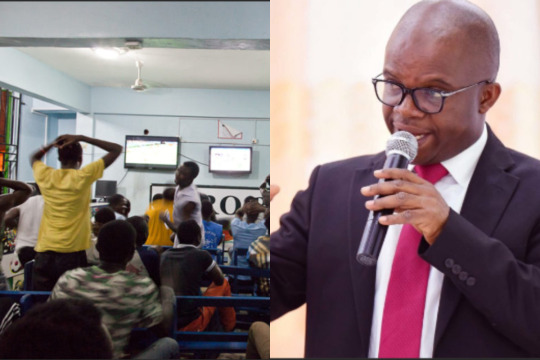#nhyiaeso
Text
Minority’s “Occupy BoG” protest merely an act for political capital – Stephen Amoah
The Member of Parliament for Nhyiaeso, Dr Stephen Amoah, says the Minority’s intended protest against the Governor of the Bank of Ghana, Dr Ernest Addison and his two deputies is to simply an act for political capital.
According to him, as the election period draws nigh, “they [Minority] will embark on all sort of activities to get people into making arbitrary decisions and then vote for…

View On WordPress
0 notes
Text
We’ve regretted making Sticka our MP – Angry residents mad over deplorable roads
We’ve regretted making Sticka our MP – Angry residents mad over deplorable roads
Furious occupants of Sokoban in the Nhyiaeso Constituency of the Ashanti Region have unveiled that they have lamented deciding in favor of Dr. Stephen Amoah referred to as Sticka as their Member of Parliament(MP).
“Sticka has disheartened us and he shouldn’t challenge come to Sokoban again in light of the fact that we are prepared to confront him assuming he actually thinks about coming here”…

View On WordPress
0 notes
Text
At Tafo Nhyiaeso, a man was lynched
At Tafo Nhyiaeso, a man was lynched
A SUSPECTED thief was allegedly lynched by an enraged mob near Tafo Nhyiaeso’s Moro Market.
The dead, whose name has yet to be established, is alleged to have attacked the area on a robbery mission.
Unfortunately for him, some residents of the densely populated area spotted him before he could strike.
He was allegedly pelted with stones, sticks, and metals until he finally succumbed.
His deceased…

View On WordPress
0 notes
Text
Man Lynched At Tafo Nhyiaeso
Man Lynched At Tafo Nhyiaeso
A SUSPECTED thief has allegedly been lynched by an irate mob around Moro Market at Tafo Nhyiaeso.
The deceased, whose identity is still unknown, is said to have stormed the area on a robbery expedition.
Unfortunately for him, some people in the populated community spotted him even before he could strike.
He was reportedly hit with stones, sticks and metals until he eventually gave up the…
View On WordPress
0 notes
Photo

Tasty, yummy, delicious 🍕. Call to place your order. #QueensRestaurant #Pizza #Kumasi #Nhyiaeso #restaurant #Pastery #Food #friedyam #friedrice #friedchicken #jollofrice #bankutilapia (at Nhyiaso, Kumasi) https://www.instagram.com/p/CBz8OWXJWz5/?igshid=ytomjo6h9kcl
#queensrestaurant#pizza#kumasi#nhyiaeso#restaurant#pastery#food#friedyam#friedrice#friedchicken#jollofrice#bankutilapia
0 notes
Text
Dr.Lawrence writes;Ghanaians are not angry enough
When you listen to the NPP’s reasons why the E-Levy should pass, you could see that Ghanaians are not angry enough. That is why they could say such foolish things to us.1. The Nhyiaeso NPP MP, Dr. Stephen Amoah, is on video saying, “they will pass the E-Levy in parliament at the right time and nobody can do anything to them”. He can only say that because he represents people who will vote for a…
View On WordPress
0 notes
Text
“Government Planning To Arrest Youths Who Engage In Sports Betting” – Ghanaian MP Reveals
“Government Planning To Arrest Youths Who Engage In Sports Betting” – Ghanaian MP Reveals
Dr. Stephen Amoah, the member of Parliament representing the Nhyiaeso constituency has opened up on measures taken by the government to deal ‘drastically’ with the youths in the country who engage in sports betting.
He said that the operation will take serious effect on people below 18 years who still engage in sports betting despite instructions laid down by various sport betting companies. He…

View On WordPress
0 notes
Text
"Beat me, beat me if you can" – MPs Stephen Amoah and Dafeamekpor 'fight' in parliament [Video]
“Beat me, beat me if you can” – MPs Stephen Amoah and Dafeamekpor ‘fight’ in parliament [Video]
Dr Stephen Amoah of Nhyiaeso and Dayi Rockson-Nelson Dafeamekpor of South Dayi squared off in parliament today.
In a video obtained by 3news.com, the MPs can be seen angrily exchanging words with colleagues while attempting to restrain Dr Stephen Amoah.
According to 3news.com, the two MPs clashed over the Keta tidal waves, which have devastated many coastal communities in the Ketu-South…

View On WordPress
0 notes
Text
I'm visiting wee ghettos as part of my effort to fight crime - Nhyiaeso MP
I’m visiting wee ghettos as part of my effort to fight crime – Nhyiaeso MP
Member of Parliament for Nhyiaeso Constituency, Stephen Amoah has taken the tour of his Constituency to ghettos.
According to him, this is a move to help fight crime in the constituency since there is a rising number of crimes.
Making this known in an interview on Kumasi-based Wontumi FM he said “I am almost done visiting all the wee camps in my area…the wee smokers from the ghetto who would step…

View On WordPress
0 notes
Text
My family was held hostage in our home for 3 hours – MP recounts encounter with robbers
The Member of Parliament for Nhyiaeso constituency, Kennedy Kwasi Kankam has recounted how he and his family were attacked by some armed robbers at his Kumasi residence in 2019.





Lala Spring Rolls Located @ Spintex Community 18
In an interview with JoyNews’ Joseph Opoku Gakpo, the MP said “My family and I were taken hostage for almost three hours.”
He explained that the experience change…
View On WordPress
0 notes
Text
28-Year-Old Lady Commits Suicide After She Found Out Childhood Boyfriend She Had Blood Covenant With Died


Terrornews,Jun 14, 2020
Twenty-eight-year-old Jennifer Agyemang has taken her own life after she discovered that her childhood boyfriend she had a blood covenant with died last year.
Reports indicate that she had lost physical contact with her boyfriend after she traveled to study abroad
According to her mother, Jennifer who was a native of Nkoranza was born at Kumasi Nhyiaeso.
From…
View On WordPress
0 notes
Text
We can’t win in 2024 if our numbers don’t improve in the Ashanti Region – Mahama to NDC supporters
John Dramani Mahama, flagbearer aspirant of the National Democratic Congress (NDC) has underscored the importance of the Ashanti Region to the fortunes of the opposition party.
He said the NDC stands a big chance in the next general elections if they get substantial number of votes in the Ashanti Region.
The former president and NDC 2024 flagbearership aspirant told supporters in Nhyiaeso on day…

View On WordPress
0 notes
Text
Bosomtwe: 12-year-old boy allegedly escapes from kidnappers at Feyiase
Bosomtwe: 12-year-old boy allegedly escapes from kidnappers at Feyiase
A 12- year old boy has recounted how he escaped from alleged kidnappers at Feyiase in the Bosomtwe District of the Ashanti Region.
The boy, Godfred Boateng, narrating the incident said he was accosted and taken away by an unknown man while playing football at Tafo-Nhyiaeso in the Tafo-Pankrono Municipality.
According to him, he was playing a football match with his friends at the back of…

View On WordPress
0 notes
Text
Ocular Health Assessment of Basic School Children in the Oforikrom Sub- Metropolis, Kumasi-Ghana-Juniper Publishers

Abstract
Background: Vision is critical for daily activities and sight is treasured by all. Eye diseases and disorders such as uncorrected refractive errors, cataract, glaucoma and retinopathies, tend tomar normal vision.
Purpose: To determine the prevalence of ocular conditions, their association with age and gender and the commonest associated symptoms experienced by the basic school children in the Oforikrom sub-metropolis of the Kumasi Metropolis of Ghana.
Design: A descriptive, cross sectional survey was used.
Methods: Out of the ten sub-metros in Kumasi, simple rando
m technique was used to select a sub-metropolis. The multistage sampling technique was then used to select two public primary schools in the selected sub-metropolis as well as to identify a sample of school children aged 5-16 years. The examination procedures adopted included history-taking, visual acuity testing, plus-one blur test, static retinoscopy, subjective refraction and ophthalmoscopy.
Results: A total of 500 children were examined and refractive error was found to be the most prevalent ocular condition occurring among 200 (40.0%) of the school children, followed by allergic conjunctivitis 111 (22.2%) and dry eyes 51(10.2%). The commonest symptoms recorded include itchiness (38.40%), tearing (32.4%), red eyes (30.20%) and headache (26%).
Conclusion: Uncorrected refractive error was the most prevalent ocular condition and this study indicates that the school age is a high risk group for developing refractive errors. Eye screening of school children is recommended and eye care services, especially, refractive error services should be enforced.
Key words Ocular, Assessment, Vision, Refractive error, Screening, Symptoms, Prevalence
Introduction
Poor vision in childhood affects performance in school or at work and has a negative influence on the future life of a child. Moreover, planning of the youth’s career is very much dependent on visual acuity, especially in jobs for the navy, military, railways and aviation (Gupta et al. [1]; Brown et al. [2]).
Assessment of ocular health in children is important because while some eye conditions are just causes of ocular morbidity, others invariably lead to blindness. Also while some conditions such as refractive errors and cataract are treatable others like measles and vitamin A deficiency are largely preventable. Many ocular diseases have their origin in childhood and the morbidity may go unnoticed in the absence of any form of ocular assessment because unlike adults, children have no effective means of reporting ocular problems (Deshpange et al. [3]). Kamath et al. [4] reported that children do not complain of defective vision, and may not even be aware of the condition. They try adjusting to the problem of defective vision by sitting in the front benches, holding the books close to their eyes, squeezing the eyes.
The school age is a formative period, physically as well as mentally, transforming the child into a promising adult. As such, health habits formed at this age will be carried to adult age, old age and even to the next generation (Kamath et al. [4]). This means that, not only will the child carry the effects of untreated poor ocular health into adulthood, but also ocular hygiene and health seeking behaviors cultivated in childhood as well.
Many ocular diseases from poor ocular health have their origin in childhood and the morbidity may go unnoticed and adversely affect the child’s performance in school and may also cause severe ocular disability in the later part of life (Deshpange et al. [3]). According to Gupta et al. [1], school children are easily accessible and schools are the best forum for imparting health education to the children, and schools are also one of the best centers for effectively implementing the comprehensive eye healthcare program. Ocular health assessment in school children is therefore one of the best modules in early detection and treatment of preventable blindness in children.
Data reported worldwide suggest that there is wide regional variation in the major causes of blindness in children; lesions of the central nervous system predominate in the developed countries and corneal scarring as a result of acquired diseases predominate in poor countries (Rushood et al. [5]).
Good ocular health also ensures that school children can attain their full potential in the course of their education (Deshpange et al. [3]). Periodic screening of school children therefore is very critical to improving the quality of vision in childhood. This goes on to buttress the fact that development of visual screening programs in elementary schools is essential to ensure early detection and treatment of refractive errors and eye disorders.
It has been reported that poor ocular health adversely affect the child’s performance in school and may also cause severe ocular disability in the later part of life (Deshpange et al. [3]). Thus, effective ocular health assessment in early life invariably helps in preventing long-term visual disability. Another issue of concern in poor ocular health in children is the potential of childhood blindness. Childhood blindness affects, not the child alone, but the entire family and many of them are left as street beggars in the poor countries (Khalil et al. [6]). Poor ocular health in children affects childhood development, educational performance as well as social and employment opportunities (Prakash et al. [7]).
The purpose of this study is to determine the prevalence of eye diseases, their association with age and gender and the commonest associated symptoms among basic school children in the Oforikrom sub-metropolis of the Kumasi Metropolis of Ghana.
Material and Methods
Study area
The study was carried out in the Kumasi Metropolis in the Ashanti Region of Ghana. Kumasi has a population of 2,035,064(http://www.statsghana.gov.gh/).It is located in the transitional forest zone of Ghana and lies between latitude 6.35° – 6.40° and longitude 1.30° –1.35°, an elevation which ranges between 250 – 300 meters above sea level. The land area of the Metropolis is about 254sq/km and approximately 10 kilometers in radius. There are 119 communities and ten (10) sub-metropolitan areas which include Oforikrom, Asawase, Asokwa, Bantama, Kwadaso, Manhyia, Nhyiaeso, Subin, Suame, Tafo-Pankrono (http://kma.ghanadistricts.gov.gh/).
Study type and design
A descriptive, cross-sectional study was undertaken. A sample size of 500 basic school children aged 5 to 16 years in the Kumasi Metropolis. Out of the ten sub-metros in Kumasi, simple random technique was used to select one sub-metro. The multistage sampling technique was then used to select two primary schools in the selected sub-metropolis.
Data collection technique
Data collection took place over a period of two weeks. Consent forms were initially sent to parents/guardians of the basic school children of the selected schools to be signed and approved before thorough ocular examination took place. These were however preceded by acquiring the patient’s biodata and a comprehensive case history through questionnaires which were being filled by themselves or by aid. The ocular examination procedure was as follows:
Visual Acuity
Unaided visual acuity measurements were taken for each eye of the study participants, reading from either the Snellen letter chart or the Snellen “E” chart. Aided visual acuity was taken when a participant presented with a spectacle correction. Pinhole acuity was measured in patients whose visual acuities were found to be worse than 6/6. Improvement of the patient’s visual acuity with the pinhole, the cause of the reduction in vision could be said to be mainly refractive in nature and the maximum improvement in the vision could be attained by the use of lenses to correct errors of refraction (Renner [10]).
Refraction
Staticretinoscopy and Subjective refraction were undertaken for all the subjects whose visual acuity improved with the pinhole. Also subjects with an uncorrected visual acuity of 6/6 were considered emmetropic after passing the +1 Blur test. Subjects with an error of +/- 0.25 or more were considered ametropic.
External examination and funduscopy
Examination of the external eye including the eyelashes, lids, cornea, conjunctiva, iris and pupil and of the fundus using the pen torch/ophthalmoscope light and the direct ophthalmoscope were undertaken respectively.
Ethical Consideration
This research was conducted with approval from the Director of the Kumasi Metropolitan Education Directorate, the heads of the selected junior and senior high schools, and from the teachers
Data Analysis
The Epi Info software, version 3.5.1 was used to analyze the data.
Results
A total of five hundred (500) pupils sampled from the study area responded to the questionnaires. The socio-demographic characteristics considered include gender, age, age group, school, stage/ educational status, Visual acuity, symptoms, and diagnosis were also included (Table 1).
From the Table 1, 241 pupils were females and 259 were males representing 48.2% and 51.8% respectively. The age range for the study sample was from 5 to 16 years. The mean and modal ages were 10.07±2.58 years and 8 years respectively (Table 2-7).
Discussion
Prevalent Ocular Conditions
From this study, refractive error (40.0%), allergic conjunctivitis (22.2%) and dry eyes (10.2%) have been indicated to be the major eye conditions among the respondents. In a study by Ajaiyeoba et al. [11] conducted on a total of 1,144 students, the major ocular disorders encountered were Allergic/vernal conjunctivitis (7.4%), Refractive error (5.8%), lid disorders (0.6%), squint (0.3%), corneal scarring (0.3%),cataract (0.2%). Adegbehingbe et al. [12] reported common ocular conditions as follows: refractive error, 13.5%, infective conjunctivitis, 6.1%, chalazion, 6.1% and squint, 5.9%.In the vision-screening project conducted by Presian et al. [13] at Baltimore, the estimated prevalence of visual morbidity was found to be 3.9%, 3.1% and 8.2% for amblyopia, strabismus and refractive errors respectively.
Prevalence of Refractive Errors
The commonest ocular condition identified in the present study was refractive error. This was consistent with the findings of Adegbehingbe et al. [12] and Presian et al. [13]. The refractive error prevalence (40.0%) comprised 32.6% hyperopia, 7.2% myopia and 0.2% astigmatism. The prevalence of hyperopia, myopia and astigmatism among the study sample were 4.6%, 6.9% and 14.1% respectively. Refractive error was defined in the present study as an error of ± 0.50 D and above for hyperopia and myopia and a cylindrical error of ≥ 0.50 D in one or both eyes, as was similarly defined in a study by Niroula et al. [14]. Hyperopia was the most prevalent refractive error observed in the study (32.6%). Previous studies among different ethnic groups have revealed myopia as the most prevalent refractive error (Shrestha et al. [15]; Al Wadaani et al. [16]). Therefore, prevalence of the different types of refractive errors differs for different ethnic backgrounds.
Ocular Conditions and Gender
From the present study, prevalence rate of refractive error was not statistically associated with gender (p=0.63520). Females had a higher refractive error prevalence rate (20.6%) than males (19.4%). Hyperopia, myopia and astigmatism were found to be higher among females than males (p values of 0.45257, 0.69101 and 0.97124 respectively). Previous studies conducted in other countries confirmed this relationship between females and higher Refractive error prevalence (Al Rowaily et al. [17]; Al Wadaani et al. [16] and Pavithra et al. [18]). Niroula et al. [14] however, found the percentage of refractive errors to be more in boys (7.59%) than in girls (5.30%). However, a study conducted among Nepalese children found no sex difference (Pokharel et al. [19]). The higher prevalence of refractive error among females could be due to the fact that women’s eyes have a shorter axial length than their male counterparts. A study by Foster et al. [20] in which mean anterior chamber depth measured in women was more shallow than in men of all ages (ANOVA, P< .0001) predisposes them to hyperopia (leading to higher prevalence of refractive error).
A statistically significant (p=0.00257) difference was observed between females (13.6%) and males (8.6%) when the prevalence rate of allergic conjunctivitis of both genders wereA statistically significant (p=0.00257) difference was observed between females (13.6%) and males (8.6%) when the prevalence rate of allergic conjunctivitis of both genders were compared. The higher prevalence rate in the females could be attributed to the fact that Ghanaian female school children are exposed to a lot of allergens in the environment than males, as they are mostly responsible for activities such as sweeping and dusting of tables and chairs in schools and at home. The rest of the ocular conditions showed no significant variation with gender
Ocular Conditions and Age
From the study, there was no significant association between the various types of refractive error and age. This was consistent with the finding of Pavithra et al. [18]. Of all the ocular conditions presented, only dry eye had a significant positive correlation with age (p=0.00255) in this study. The positive correlation could be from the fact that, academic activities such as attentive reading increases with rise in class level (which is highly dependent on age in Ghanaian primary schools).
According to Karson et al. [21], the rate of blinking when reading has been shown to decrease significantly from a resting blink rate of between 8 and 21 blinks per minute to an average of 4.5 blinks per minute. Hence the eyes are prone to getting dry as one age, moves higher in class level and do a lot of attentive reading.
Ocular Symptoms
Amongst the commonest symptoms recorded in this study, 38.40% reported itchiness, 32.4% had tearing, 30.20% had red eyes and 26% had headache. The high prevalence of these symptoms could be attributed to allergens such as dust and chalk particles in the school environment to which the school children are exposed to. Children have strong immune systems such that, they easily have hypersensitivity reactions to things in their environment. The high reportage of headache as a symptom could be attributed to the high prevalence of hyperopia within the study population. Gleason et al. [22] have stated that hyperopes must accommodate to see distant objects clearly and even more so to see closely. According to Grosvenor [23], Sheard’s criterion must be met for comfortable binocular vision. When this is not met, asthenopic symptoms which includes headache will result. This explains why most of the subjects reported experiencing headaches. Similar findings were obtained in a cross sectional study by Ajaiyeoba et al. [11].
Conclusion
Refractive error was found to be the most prevalent ocular condition among the basic school children in the Kumasi Metropolis affecting 200 (40.0%) pupils out of a sample of 500, followed by allergic conjunctivitis 111 (22.2%) and dry eyes 51 (10.2%). Amongst the commonest symptoms recorded in the research, 38.40% reported itchiness, 32.4% had tearing, 30.20% had red eyes and 26% had headache.
The ocular diseases showed no significant variation with gender apart from allergic conjunctivitis which had a statistically significant difference between females (13.6%) and males (8.6%) (p=0.00257). There was also no significant association between eye disease and age except in the case of dry eye that had a significant positive correlation with age (p=0.00255).
School health services should have eye care services incorporated, implemented and strengthened effectively. Routine eye screening and examination among school children, especially those below the age of 9 years, should be enforced as any unidentified eye disorder could easily result in amblyopia. Provision of affordable corrective services should follow screening, especially, to the school-age group.
For more Open Access Journals in Juniper Publishers please click on: https://juniperpublishers.com
For more articles in JOJ Ophthalmology please click on:
https://juniperpublishers.com/jojo/index.php
For more Open Access Journals please click on: https://juniperpublishers.com
0 notes
Photo

Order your food from @queenssportsbar Delivery available as well. #QueensRestaurant #Kumasi #Nhyiaeso #Food #JollofRice #friedchicken #Pizza #FriedRice #friedyam #porkchops #bankutilapia (at Nhyiaso, Kumasi) https://www.instagram.com/p/CBYANLEJwZq/?igshid=19gezgnj8k80u
#queensrestaurant#kumasi#nhyiaeso#food#jollofrice#friedchicken#pizza#friedrice#friedyam#porkchops#bankutilapia
0 notes
Photo

Ahodwo residents demand improved security after kidnapping of Canadians General News of Sunday, 9 June 2019 Source: citinewsroom.com File photo Residents living closer to the Royal Golf Park at Ahodwo Nhyiaeso in Kumasi, where two female Canadian nationals were kidnapped recently, want authorities to improve security in the area.
0 notes